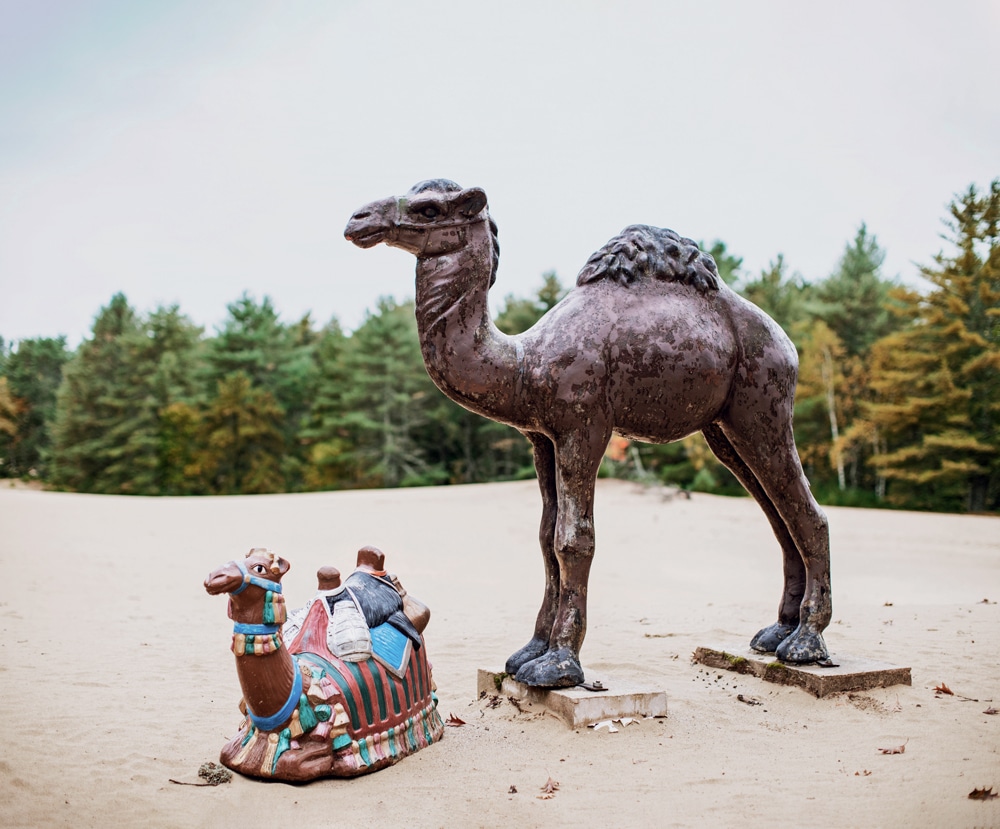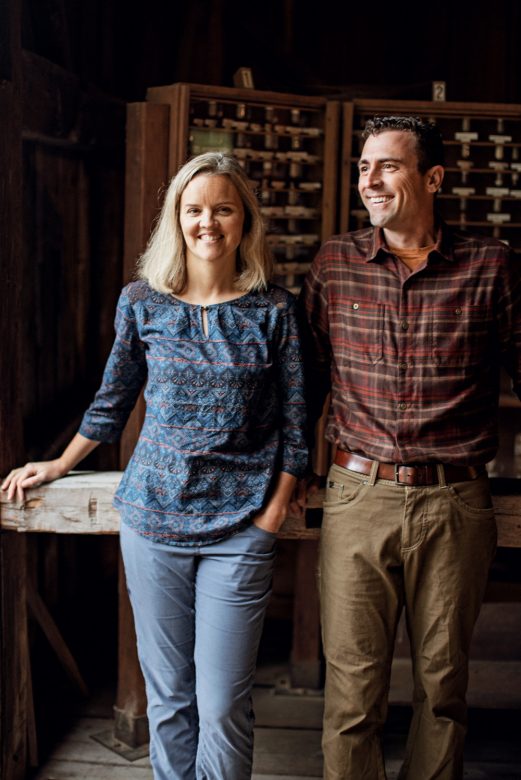Shifting Sands | Desert of Maine
A one-of-a-kind Maine tourist attraction is being reinvented for a new generation.

Opened in 1925, the Desert of Maine briefly had a live camel among its attractions; however, today’s visitors are greeted by fiberglass versions.
Photo Credit : Chris Bennett
Photo Credit : Chris Bennett
A modest slice of glacier-scoured land that generations of settlers then plowed into ruin seems an unlikely candidate for celebrity. But for nearly a century, the Desert of Maine has reigned as New England’s very own Sahara, drawing some 30,000 people a year to marvel at a 40-acre expanse of white sand that sits just a few miles from Freeport’s bustling downtown.
When I visited the Desert of Maine last fall, I found the venerable tourist attraction at a crossroads. It had recently been sold, and the new owners were bringing with them a vision that, for the first time in a long time, is focused as much on the future as it is on the past.
Although I didn’t know it at the time, I would be one of the very last people to have the “old” Desert of Maine experience, as I climbed aboard a Jeep-pulled tram for a half-hour tour. En route, our guide shared a well-worn collection of anecdotes while pointing out the property’s highlights.

Photo Credit : Chris Bennett
As we passed the fiberglass camels (a nod to the real one—sometimes friendly, sometimes prone to spitting—that had greeted visitors in the 1950s), a vista of sand dunes opened before us. The Desert of Maine gets way too much rain to be a true desert, but it sure does a credible impression. Now and then sandstorms kick up, making it hard to breathe. Looking around, I find it difficult to believe that this was once a fertile farm.
As the story goes, in 1797 a man named William Tuttle purchased this land as part of a 300-acre parcel and founded a farm on it that was successful for many years. His descendants, however, did not share his green thumb, and after ruining the soil for crops, they turned to raising sheep. Voracious eaters, the sheep stripped the land of its natural vegetation, and the topsoil eroded. At first a patch of sand the size of a dinner plate appeared. The patch grew steadily—and did not stop.
By the time the Tuttle heirs abandoned the property in the early 20th century, locals derided it as an all-but-useless “sand farm.” No one quite believed it when a man named Henry Goldrup ponied up $300 to buy it from the town in 1919. Goldrup, though, was betting on a coming wave of tourists in America, people who would travel to see unique and strange places. He dubbed the land “the Desert of Maine” and opened it to visitors in 1925. It became a popular midcentury attraction, advertised by roadside signs along still-new highways. “Gen-u-ine tourist traps” like this and others were all the rage at a time when Americans had newfound mobility and were forever in search of a place to go.
As we motored toward the pine forest at the far end of the desert, I saw what countless tourists before me had likely marveled at: a springhouse, built in the 1930s, the entire building now deeply buried in the dunes; full-size pine trees almost engulfed by drifting sand, so that only their tops are visible. And I learned that the dunes aren’t true sand—they’re silt, which was dropped over a swath of southern Maine by receding glaciers. On sunny days, the mica in the silt glistens, and its reflective nature makes this landscape one of the hottest places in Maine.
The Desert of Maine has a natural advantage over many other roadside attractions: It’s real. Not a real desert, but a bona fide geological oddity. An entertainment that made you think. Education at its sneakiest.
The educational aspects of the property were part of what inspired Mela and Doug Heestand—a former professor at Merrimack College and an IT entrepreneur, respectively—to buy this landmark last year from Gary and Ginger Currens, who had owned it since 2004 and were ready to retire.
When I met the Heestands last fall, their enthusiasm for the property was obvious, as was their respect for its history. In a release announcing their purchase, the Heestands had written, “We want families in the area to think of the Desert of Maine as a place they can come to spend the day walking the trails, learning about history, or just taking in the view.” That was true enough, but the wheels were also already turning on a grander vision.
The first change is the one that longtime fans of the desert may find the hardest to accept: replacing the Jeep and trams with walking tours (guided ones for a fee, and app-based, self-guided ones at no charge). Accommodations for visitors unable to walk the grounds are still being worked out.

Photo Credit : Chris Bennett
“We want the property to be accessible to as many people as possible, for both education and entertainment,” Mela said, setting the stage, so to speak, for the part of the new plan that she’s most excited about: the transformation of an on-site barn into an arts and performance center. An amateur musician, Mela wants to develop programs that let fledgling musicians play with and learn from more experienced players—and maybe even stage concerts on the dunes one day.
The Heestands have also been working with geologists to learn more about the desert’s natural significance. “Rather than telling the singular story of the owners of this property, there is a tale to be told about the difficulties of farming and the history of Maine,” Mela said. “We can’t be certain which of the old anecdotes are true, but there are exciting opportunities for in-depth, fact-based programs here.” In addition to creating programs for locals, the Heestands want to launch an arts foundation to draw kids from other states.
Reinventing an iconic landmark while preserving its legacy is a daunting task, but the Heestands are counting on visitors’ willingness to see the desert with fresh eyes even as they feel the same appreciation for its wonder. “People seem happy that we want to do something different,” Mela said. “It’s time for a new chapter.”
To learn more, go to desertofmaine.com.
Joe Bills
Associate Editor Joe Bills is Yankee’s fact-checker, query reader and the writer of several recurring departments. When he is not at Yankee, he is the co-owner of Escape Hatch Books in Jaffrey, NH.
More by Joe Bills

